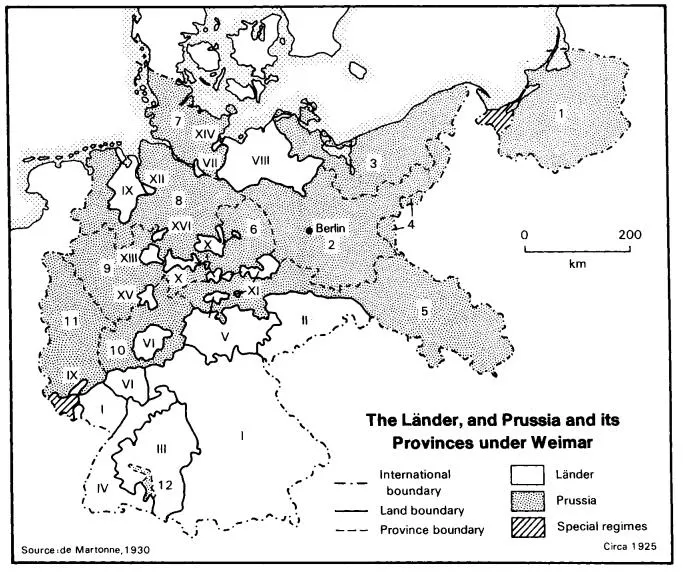
eBook - ePub
Atlas of Nazi Germany
Michael Freeman, Jayne Lewin, Tim Mason
This is a test
- 232 pages
- English
- ePUB (mobile friendly)
- Available on iOS & Android
eBook - ePub
Atlas of Nazi Germany
Michael Freeman, Jayne Lewin, Tim Mason
Book details
Book preview
Table of contents
Citations
About This Book
Originally published in hardback only in 1987, Michael Freeman's valuable guide to the history of Nazi Germany now returns to print in a substantially revised Second Edition. Dealing with all aspects of the Nazi regime, it is far more than just an atlas: the integration of the maps themselves with charts and other visually-displayed data, and an extensive and authoritative commentary, makes this a book to read as well as to refer to.
Frequently asked questions
At the moment all of our mobile-responsive ePub books are available to download via the app. Most of our PDFs are also available to download and we're working on making the final remaining ones downloadable now. Learn more here.
Both plans give you full access to the library and all of Perlego’s features. The only differences are the price and subscription period: With the annual plan you’ll save around 30% compared to 12 months on the monthly plan.
We are an online textbook subscription service, where you can get access to an entire online library for less than the price of a single book per month. With over 1 million books across 1000+ topics, we’ve got you covered! Learn more here.
Look out for the read-aloud symbol on your next book to see if you can listen to it. The read-aloud tool reads text aloud for you, highlighting the text as it is being read. You can pause it, speed it up and slow it down. Learn more here.
Yes, you can access Atlas of Nazi Germany by Michael Freeman, Jayne Lewin, Tim Mason in PDF and/or ePUB format, as well as other popular books in Historia & Historia del mundo. We have over one million books available in our catalogue for you to explore.
Information
Prelude
1 The Weimar Republic
The Weimar Republic came into being in the midst of the German war defeat in the autumn of 1918. Rising popular disaffection with the military and the monarchy precipitated a revolutionary movement beginning with naval mutinies at Kiel in late October and followed by the rapid establishment of soldiers’ and workers’ councils throughout most German cities in much the same mould as had occurred in Russia that year. By the second week of November, a reformist socialist government was in place, a republic had been declared, the Kaiser had abdicated and was in exile in Holland, and the army’s war leaders had been forced from the centre stage.
The new government proved hardly revolutionary in mould. It was dominated by moderate socialists (SPD) who still clung to elements of the pre-war political scene; indeed, the administrative continuity with the past proved to be one of the most remarkable features of the German revolution. One result was that more revolutionary but minor socialist groups were quickly alienated and, later, were subject to violent suppression, with the help of newly formed army units. The threads of political continuity were reinforced, moreover, when in the first parliamentary election in January 1919, the socialists (SPD and USPD) were able to form a government only with the support of the Catholic Centre Party (Zentrum) and the German Democratic Party (DDP).
The ‘Weimar constitution’ was adopted by the Reichstag, or Parliament, in August 1919. It was exceptionally democratic in that it gave the vote to all men and women at the age of 20, embraced proportional representation in elections and, more widely, sought to specify the basic rights of citizens in a democratic state. The latter encompassed, for example, the protection of religious freedoms, the facility with which workers could combine, as well as laying out the critical elements of a modern welfare state. Governments were responsible to Parliament and there was to be a strong popularly elected President. Provisions were also made for popular referenda. The relationship between the central government and the sovereign states of Bismarck’s Reich was redefined to give much greater control at the centre. The states henceforward became Länder, their powers of self-administration confined to the police, the judiciary and education. In the second parliamentary chamber set up under the Weimar constitution, the Reichsrat, the Länder supposedly gained a broader measure of influence on government. But, in practice, the Reichsrat was subservient to the Reichstag, which was in turn somewhat overshadowed by the Reich government. For many later commentators, the fatal flaw in the Weimar constitution was the way that it laid out administrative machinery which could be given definition and substance only through subsequent legislative and political decision. In defence, one may say that the constitution was so formed because of the way it sought to reflect competing political pressures. In modern parlance, it allowed for multiple solutions.

Fig. 0.1 The Länder, and Prussia and its Provinces under Weimar
Länder
I Bavaria
II Saxony
III Württemberg
IV Baden
V Thuringia
VI Hesse
VII Hamburg
VIII Mecklenburg-Schwerin
IX Oldenburg
X Brunswick
XI Anhalt
XII Bremen
XIII Lippe
XIV Lübeck
XV Waldeck
XVI Schaumburg-Lippe
XVII (Prussia)
Prussian Provinces
1 East Prussia
2 Brandenburg
3 Pomerania
4 Grenzmark Posen Westpreussen
5 Silesia
6 Saxony
7 Schleswig-Holstein
8 Hanover
9 Westphalia
10 Hessen-Nassau
11 Rhine Province
12 Hohenzollern
The internal political geography of Germany under the Weimar regime was among the most complicated of all contemporary European countries. (Fig. 0.1) Before the birth of Hitler’s state, Germany was divided into no less than 17 Länder, the largest of which was Prussia, covering some 60 per cent of the country’s land area and embracing some 60 per cent of its population. Prussia was itself divided into separate provinces. The remaining Länder varied wildly in size and population. Bavaria, for instance, had an area of 78,000 square kilometres and a population of some 8 million, while Schaumburg-Lippe had corresponding figures of 340 and 50,000. The resulting geographical mosaic was predictably very confused. While Prussia was the dominant force across the northern half of the country and Bavaria, by virtue of its large size, likewise in the south, the small German Länder were distributed across the face of western Germany, many of them also having detached territorial outliers to add further to the confusion.
Assessments of the Weimar Republic must necessarily consider the various historical exigencies within which it was framed. Few could deny that it was a remarkable experiment in democracy; but it fell victim to both internal antagonisms and those on the wider historical stage, the Versailles peace treaty among them.
2 Versailles and the Weimar Republic
The Treaty of Versailles of 1919 redrew the political map of Europe on an unprecedented scale. (Fig. 0.2) For Germany, however, the territorial adjustments required by the Treaty were limited. Alsace-Lorraine was restored to France (having been taken from France in 1871). Minor frontier adjustments were made at Germany’s expense in favour of Belgium, Czechoslovakia and Denmark. Territory was lost in the east to the recreated state of Poland, much of it land which had been seized by Prussia in the eighteenth century. But, in total, Germany had to relinquish only 13 per cent of its territory, containing approximately 10 per cent of its population. Alongside the consequences of the Treaties of St Germain and Trianon for the Austro-Hungarian Empire, or compared with the humiliating territorial losses imposed by Ger...
Table of contents
- Cover
- Half Title
- Title Page
- Copyright Page
- Table of Contents
- Foreword to first edition
- Preface to first edition
- Preface to second edition
- Acknowledgements
- Abbreviations
- Introduction
- Prelude
- 1 The Weimar Republic
- 2 Versailles and the Weimar Republic
- Part One: The rise of the Nazi Party
- Part Two: Administrative and political structure
- Part Three: Society
- Part Four: Population and economy
- Part Five: The search for living space: the Third Reich at war
- Part Six: The War Machine
- Epilogue
- Epilogue
- References for maps and diagrams
- Select bibliographical guide
- Glossary
- Index